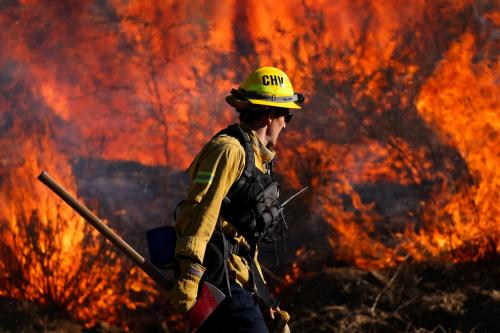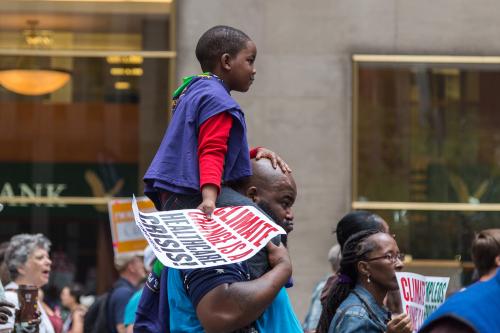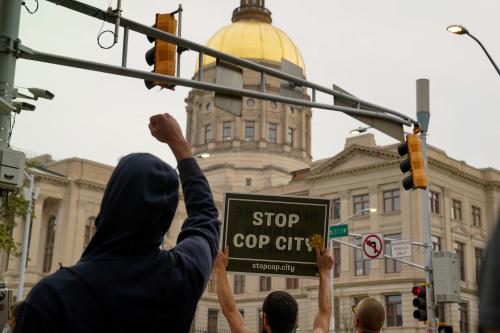The summer of 2023 saw the globe experience some of the hottest days in recorded history. Yet the impact of this heat was not evenly felt. As climate journalist Jeff Goodell wrote, “Poverty equals vulnerability. If you have money, you can turn up the air conditioning, stock up on food and bottled water, and install a backup generator in case there’s a blackout.”
In the U.S., wealth is deeply connected to race and homeownership. Which means that Black renters, specifically, face a disproportionate burden of the impacts of climate change and extreme heat.
The analysis in this report finds that in 2020, Black renters had greater energy insecurity than white renters, Black homeowners, and white homeowners—meaning they were unable to pay an energy bill, forwent crucial bills such as rent or groceries, or kept their homes at unsafe temperatures. Such energy insecurity can be a lethal manifestation of climate vulnerability; beyond the cost burden of staying cool, it puts lives at greater risk of heat-related illness and death, impairs wealth-building, and hampers well-being.
In previous publications, we have argued for implementing reparative climate policies that would address the root causes of environmental racism and inequity while supporting policy responses that build the resilience and adaptive capacity of historically marginalized communities. Similarly, this report suggests state and local government interventions that could fit within a reparative policy framework, including energy bill assistance, retrofitting and weatherizing homes, investing in neighborhood heat resilience, and expanding access to affordable, renewable energy sources. While funding for these solutions exists, it is often only through minor portions of larger climate policies that do not directly target Black renters or their neighborhoods, despite their high vulnerability and need.
Paying more for energy in a climate crisis can be deadly
Extreme heat is the deadliest climate hazard in the United States. And while heat itself does not discriminate, centuries of racist housing policies such as redlining magnify its impact. Such policies segregated Black neighborhoods, induced lower rate rates of homeownership, and ensured underinvestment in those communities—all of which make Black residents more vulnerable to extreme heat. In 2021, the Environmental Protection Agency reported that Black people are 40% more likely than non-Black people to live in areas with the highest projected increase in mortality rates due to extreme temperatures.
The underinvestment of Black neighborhoods means a disproportionate share of Black residents live in older homes without air conditioning or proper insulation, and on streets that lack green spaces to help lower ambient temperatures. One study found that 94% of formerly redlined areas are hotter than non-redlined areas within the same county by as much as 12.6 degrees Fahrenheit.
Homes occupied by Black renters are often inadequate in dealing with extreme heat due to underinvestment. And our history of racist housing policy has led to these Black renters paying proportionally more to stay safe during heat waves than other racial groups. In July of last year, 50% of Black renters were unable to pay their energy bills.
Extreme temperatures make cooling homes a necessity, which drives up energy bills and exacerbates cost disparities for residents. Energy insecurity measures the ramifications of this dynamic, which includes keeping homes at unsafe temperatures to keep energy costs low; forgoing other bills such as groceries or medicine to keep up with payments; or going without air conditioning to make other crucial payments such as rent.
Nationwide and across states, Black renters see high rates of energy insecurity
Although many households struggle with energy insecurity, renters tend to have higher energy cost burdens than homeowners, meaning they pay a higher portion of their income on energy. So, as climate change leads to more extreme heat waves, Black families who have been locked out of homeownership and reside in neighborhoods with higher ambient heat will continue to be among the most energy-insecure and climate-vulnerable groups.
Using data from the Energy Information Administration’s 2020 Residential Energy Consumption Survey, we can compare energy data between Black renters, Black homeowners, white renters, and white homeowners.
We find that in 2020, over half of all Black renters in the U.S. were energy insecure, and therefore at a greater risk of climate-related mortality compared to white renters (only 36% of whom were energy insecure). For both racial groups, energy-insecurity rates were lower if the occupant owned their home, however racial disparities remained.
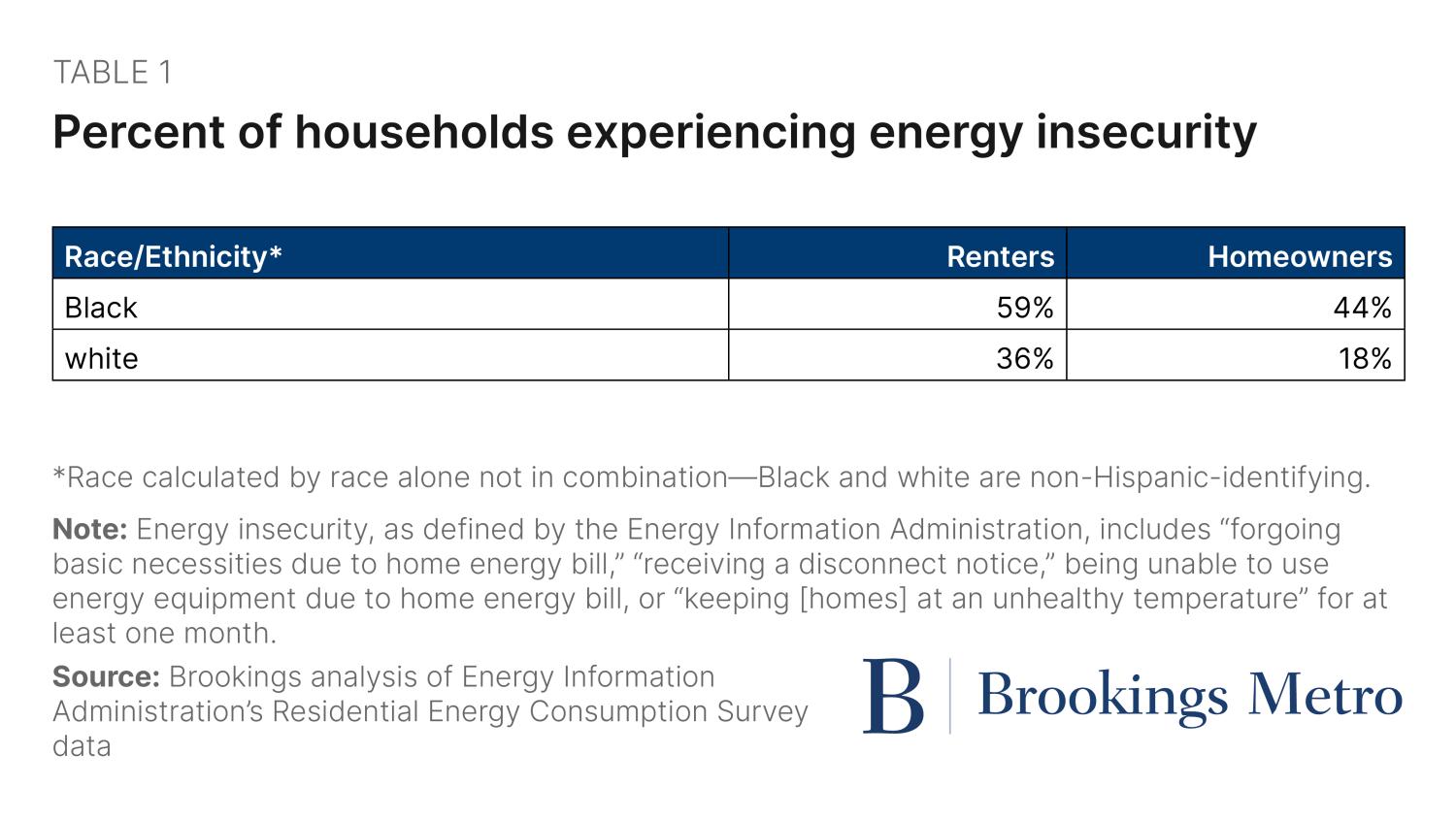
Looking at the state level, energy insecurity for Black renters remains above 50% in the majority of states and Washington, D.C. In six states (Kansas, New Mexico, North Dakota, South Dakota, Oklahoma, and Rhode Island), 100% of Black renters fulfilled at least one requirement of being energy insecure, while less than 40% of white renters were energy insecure.
Energy insecurity for Black renters is especially widespread in the South and West regions. As Table 2 shows, on average, 68% of Black renters in the South and 75% of Black renters in the West were energy insecure, while white renters were less vulnerable across all regions. Notably, even states in the Midwest and Northeast with relatively small Black populations have exceptionally high rates of energy insecurity among Black renters.
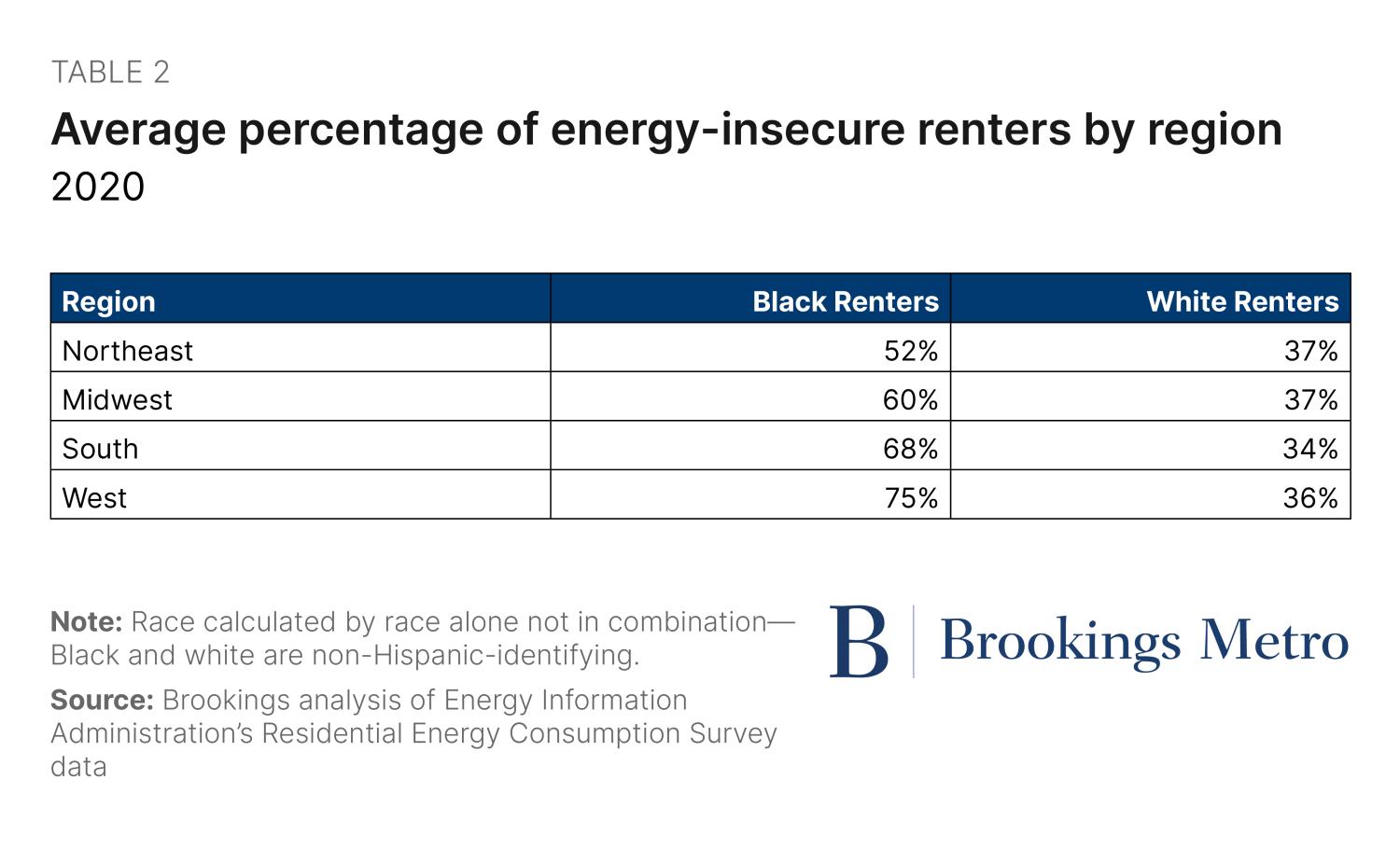
This study compares Black and white renters and homeowners because of the distinct, systemic differences in access to safe and sustainable housing in the United States. Other communities of color—especially Native American and Latino or Hispanic communities—also suffer from energy insecurity. However, across the board, Black renters have dramatically higher levels of energy insecurity. The following policy suggestions are therefore not an argument that all policy solutions be drafted solely for Black renters, but that more policies should address this specific gap in safety and resources.
Recommendations for using existing legislation to build a reparative climate policy
Reparative climate policy aims to minimize the impacts of climate change in ways that recognize how they are connected to a history of unjust and racially discriminatory policies. Critical examples include investing in historically devalued communities to support their resilience, adaptive capacity, and economic self-determination.
Previously, we discussed how recent federal climate policy—although a major step forward, especially for mitigation and decarbonization—is not reparative, because it sidesteps questions of racial equity and prioritizes one-size-fits-all mechanisms over those that consider distributional impacts. However, states can utilize the funds and programs made accessible by the Inflation Reduction Act (IRA) and Infrastructure Investment and Jobs Act (IIJA) to directly repair the racialized harms that have made Black renters so energy insecure.
Below, we discuss how existing legislation can be leveraged to alleviate energy insecurity. However, we must acknowledge that longer-term, structural solutions for this issue make up only small portions of the IRA and IIJA. Additionally, policy should aim to reduce energy insecurity for all renters and low-income homeowners, but Black renters are worth focusing on because they are some of the most energy insecure and are still impacted by other race-based inequities that amplify climate vulnerabilities.
Intentionally implement energy bill assistance and home weatherization programs to benefit Black renters
Of the $863.7 billion allocated in the IIJA, $6.5 billion (0.75%) is going to energy efficiency and building infrastructure, including through the Low Income Home Energy Assistance Act (LIHEAP), which makes funds available for direct energy bill assistance. A reparative solution to racial disparities in energy insecurity would see states strategically reach out to Black renters to ensure they have the tools and resources to apply for LIHEAP funding.
While around 8% of this funding will go to LIHEAP, over half will go to the Weatherization Assistance Program (WAP). WAP funding is available for states and other entities to retrofit older homes for improved energy efficiency. In order to address the gap in investment and need, states should utilize the $3.5 billion in WAP funding from the IIJA to target Black-majority neighborhoods with high rates of rental properties, which can decrease energy insecurity and its associated health and safety risks for some of the most vulnerable households.
Protect the ability of Black renters to stay in their homes and benefit from energy upgrades without displacement
The IRA made a $9 billion investment in the Home Energy Rebate program to cut upfront costs for energy-efficient repairs for multifamily units, which incentivizes rental property owners to make changes that can cut back on energy insecurity. But rental property owners may be incentivized to take advantage of these rebates in a way that does not protect low-income or long-term renters, who can be priced out as energy system upgrades increase home values.
Therefore, policymakers must protect the ability of Black renters to stay in their homes and benefit from energy upgrades without displacement. Local leaders should expand inclusionary zoning for affordable housing and consider consumer protections—such as rent control—as property owners begin utilizing these funds. Additionally, rather than tax credit incentives, state programs to retrofit homes are a longer-term investment in reducing climate vulnerability, especially for renters who lack the autonomy to make permanent renovations to their homes due to lease agreements or income restrictions.
Invest in neighborhood heat mitigation to reduce energy insecurity for Black renters
Despite ongoing work by the Biden administration, neither the IIJA nor IRA have substantial program or funding allocations for changes to the built environment that will mitigate heat. However, at the state level, there are multiple programs focused on cooling neighborhoods, often through planting trees and vegetation or building “green roofs” and pavements that reflect rather than hold heat.
The American Planning Association suggests all of these tools for urban heat resilience, but so far, these types of investments do not center disparities for Black renters. States should build off this moment in climate resilience policy by first targeting Black-majority communities, which suffer from increased high heat risk, especially those with a high concentration of renters.
Prioritize access to affordable energy alternatives for the most energy-insecure individuals
The most long-term investment in reducing energy insecurity and climate vulnerability is prioritizing Black renters’ access to alternative energy sources such as wind and solar, which simultaneously divests from human systems that worsen climate change and lowers energy costs burdens.
The IRA allocated $27 billion (7.3% of its total) to the Greenhouse Gas Reduction Fund (GHGRF)—presenting an opportunity for states and other entities to implement long-term solutions to lower energy costs and invest in communities. Reparative uses of these funds would include expanding access to alternative energy sources for Black renters, such as through the GHGRF’s Solar for All grant competition, which seeks to expand solar access for low-income communities. The competition will only fund 60 grantees, which will not expand solar “for all,” but it is an ideal funding source for decisionmakers who want to expand renewable energy access for Black renters. States should utilize these funds, but given their limitations, also prioritize similar projects in their own budgets.
There is a gap in climate policy, leaving Black renters to sweat it out
Black renters are one of the most disproportionately impacted groups for energy insecurity. But our federal policies don’t yet reflect that, nor do they fund all the necessary projects to combat racialized disparities.
In lieu of adequate federal policy, implementing more reparative climate policy at the state and local level would support the safety and security of Black renters now while working to build a more equitable and sustainable energy system. As we enter the era of global boiling, we must better deploy precious public resources to support those most impacted by the direct and indirect impacts of climate change.




